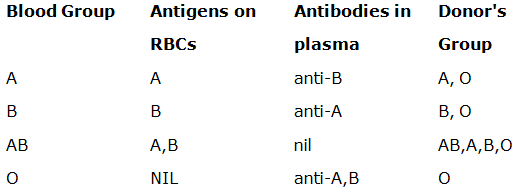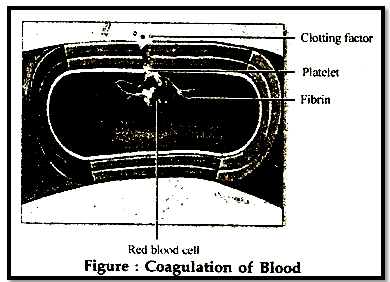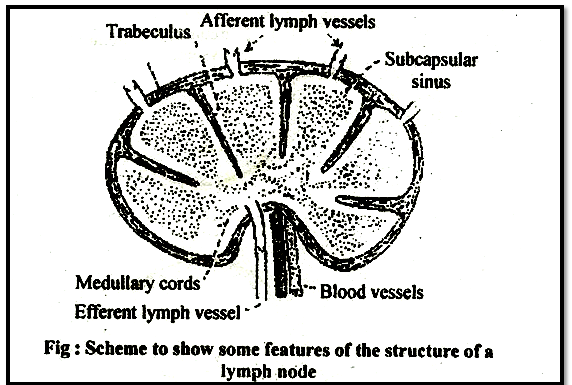Blood Lymph and Spleen
Table of Content |
Blood
 Blood is a special connective tissue consisting of a fluid matrix, plasma, and formed elements.
Blood is a special connective tissue consisting of a fluid matrix, plasma, and formed elements.
Plasma is a straw coloured, viscous fluid constituting nearly 55 per cent of the blood. 90-92 per cent of plasma is water and proteins contribute 6-8 per cent of it.
Fibrinogen, globulins and albumins are the major proteins.
Fibrinogens are needed for clotting or coagulation of blood. Globulins primarly are involved in defense mechanisms of the body and the albumins help in osmotic balance.
Plasma contains small amounts of minerals like Na+, Ca++, Mg++, HCO3, Cl-, etc. Glucose, amino acids, lipids, etc., are also present in the plasma as they - are always in transit in the body. Factors for coagulation or clotting of blood are also present in the plasma in an inactive form. Plasma without the clotting factors is called serum.
Erythrocytes, leucocytes and platelets are collectively called formed elements and they constitute nearly 45 per cent of the blood.
Erythrocytes or red blood cells (RBC) are the most abundant of all the cells in blood.
A healthy adult man has, on an average, 5 millions to 5.5 millions of RBCs mm-3 of blood.
RBCs are formed in the red bone marrow in the adults.
RBCs are devoid of nucleus in most of the mammals and are biconcave in shape. They have a red coloured, iron containing complex protein caned haemoglobin, hence the colour and name of these cells. A healthy individual has 12-16 gms of haemoglobin in every 100 ml of blood. These molecules play a Significant role in transport of respiratory gases.
RBCs have an average life span of 120 days after which they are destroyed in the spleen (graveyard of RBCs).
Leucocytes are also known as white blood cells (WBC) as they are colourless due to the lack of haemoglobin. They are nucleated and are relatively lesser in number which averages 6000-8000 mm3 of blood. Leucocytes are generally short lived.
Two main categories of WBCs - granulocytes and agranulocytes. Neutrophils, eosinophils and basophils are different types of granulocytes, while .lymphocytes and monocytes are the agranulocytes.
Neutrophils are the most abundant cells (6-5 per cent) of the total WBCs and basophils are the least (0.5-1 per cent) among them. Neutrophils and monocytes (6-8 per cent) are phagocytic cells which destroy foreign organisms entering the body.
Basophils secrete histamine, serotonin, heparin, etc., and are involved in inflammatory reactions.
Eosinophils (2-3 per cent) resist infections and are also associated with allergic reactions.
Lymphocytes (20-25 per cent) are of two major types - 'B' and 'T' forms. Both Band T lymphocytes are responsible for immune responses of the body.
Platelets also called thrombocytes, are cell fragments produced from megakaryocytes (special cells in the bone marrow). Blood normally contains 1,500,00-3,500,00 platelets mm-3. Platelets can release a variety of substances most of which are involved in the coagulation or dotting of blood. A reduction in their number can lead to clotting disorders which will lead to excessive loss of blood from the body.
Blood Grpoups
1. ABO grouping:ABO grouping is based on the presence or absence of two surface antigens (chemicals that can induce immune response) on the RBCs namely A and B. Similarly, the plasma of different individuals contain two natural antibodies (proteins produced in response to antigens). The distribution of antigens and antibodies in the four· groups of blood, A, B, AB and O are:
Group 'O' blood can be donated to persons with any other blood group and hence 'O' group individuals are called 'universal donors'.
Persons with 'AB' group can accept blood from persons with AB as well as the other groups of blood. Therefore, such persons are called 'universal recipients'.
2. Rh grouping:Antigen, the Rh antigen similar to one present in Rhesus monkeys (hence Rh), is observed on the surface of RBCs of majority (nearly 80 per cent) of humans. Such individuals are called Rh positive (Rh + ve) and those in whom this antigen is absent are called Rh negative (Rh-ve).
An Rh-ve person, if exposed to Rh+ve blood, will form specific antibodies against the Rh antigens. Therefore, Rh group should also be matched before transfusions.
A special case of Rh incompatibility (mismatching) has been observed between the Rh-ve blood of a pregnant mother with Rh+ve blood of the foetus. Rh antigens of the foetus do not get exposed to the Rh-ve blood of the mother in the first pregnancy as the two bloods are well separated by the placenta. However, during the delivery of the first child, there is a possibility of exposure of the maternal blood to small amounts of the Rh+ve blood from the foetus. In such cases, the mother starts preparing antibodies against Rh in her blood. In case of her subsequent pregnancies, the Rh aritibodies from the mother (Rh-ve) can leak into the blood of the foetus (Rh+ve) and destroy the foetal RBCs. This could be fatal to the foetus or could cause severe anaemia and jaundice to the baby. This condition is called erythroblastosis foetalis. This can be avoided by administering anti Rh antibodies to the mother immediately after the delivery of the first child.
Coagulation of Blood
A clot or coagulam formed mainly of a network of threads called fibrins in which dead and damaged formed elements of blood are trapped. Fibrins are formed by the conversion of inactive fibrinogens in the plasma by the enzyme thrombin. Thrombins, in turn are formed from another inactive substance present in the plasma called prothrombin. An enzyme complex, thrombokinase, is required for the above reaction. This complex is formed by a series of linked enzymic reactions (cascade process) involving a number of factors present in the plasma in an inactive state.
An injury or a trauma stimulates the platelets in the blood to release certain factors which activate the mechanism of coagulation.
Calcium ions playa very important role in clotting.
Lymph
As the blood passes through the capillaries in tissues, some water along with many small water soluble substances move out into the spaces between the cells of tissues leaving the larger proteins and most of the formed elements in the blood vessels. This fluid released' out is called the interstitial fluid or tissue fluid.
Exchange of nutrients, gases, etc., between the blood and the cells always occur through this fluid.
An elaborate network of vessels called the lymphatic system collects this fluid and drains it back to the major veins. The fluid present in the lymphatic system is called the lymph.
Lymph is a colourless fluid containing specialised lymphocytes which are responsible for the immune responses of the body.
Lymph is also an important carrier for nutrients, hormones, etc. Fats are absorbed through lymph in the lacteals present in the intestinal villi.
Lymph = Blood - [RBC + platelets + plasma proteins of high molecular weight]
In human primary lymphatic (lymphoid) organs of the body are the Red bone marrow and Thymus gland. They are called primary lymphatic organs because they produce Band T cells, the lymphocytes that carry out immune response. Haemopoietic stem cells in red bone marrow gives rise to B Cell and pre- T cells. Pre-T cells then migrate to thymus gland. Secondary lymphatic organs are the lymph nodes and spleen.
Lymph Capillaries:
These are blind at one end.
These are very soft and thin walled tubes.
They are wider than blood capillaries and their diameter is not uniform.
These are present in all the parts of body except hairs, cornea, spinal cord, cartilages, epidermis, brain Spleen and bone marrow.
Closed system of capillaries starts from inter cellular spaces. Lymph enters in these capillaries.
Capillaries pass this lymph to lymph vessels.
Lymph Vessels:
The lymphatic capillaries join to form lymph vessels.
In the structure, these are 'similar to the veins, but in these, thin wall and more valves are found than veins.
All lymph vessels open into two big thoracic lymph duct. These are:
(i) Right thoracic lymph duct: It is the small duct. It receive lymph from the right side of the head, neck, thorax and right arm. It opens into the right subclavian vein.
(ii) Left thoracic lymph duct: It is the long duct. It receives lymph from the left side of the head, neck, thorax, left arm, both hind limbs and alimentary canal. It opens into the left subclavian vein.
In the abdominal cavity behind the diaphgram a bag like structure attached with left thoracic lymph duct called cisterna chyli. It is called second heart of body.
Lymph Nodes:
These are made up of lymphoid tissue.
The lymphatic nodes occur at intervals in the course of the lymphatic vessels.
They contain lymphocytes, plasma cells and fixed macrophages.
The lymph filters through the lymphatic nodes.
The macrophages remove microorganism, cellular debris and foreign particles from the lymph.
Lymphatic nodes can detect and destroy cancer cells also.
The lymphatic nodes also add lymphocytes and antibodies to the lymph.
The lymphatic nodes are specially abundant in specific regions such as the groins, armpits and neck.
Spleen
The spleen is a large (7-10 cm. in diameter), bean shaped, vascular, dark-red organ located in the abdomen just below the diaphragm at the tail of the pancreas behind the stomach.
It is the largest lymph nodes.
It is also called blood bank of body.
It is the graveyard of RBC.
It is mesodermal in origin.
Like lymph nodes, spleen has hilus/where splenic, artery, vein and efferent lymphatic vessels' pass through. Spleen never filter lymph, because has no afferent lymphatic vessel. Histologically it is formed by following structure –
(a) Capsule: It is the outer covering of spleen formed of dense connective tissue and smooth muscles. The outer layer of the capsule is the serous coat formed of visceral peritoneum.
(b) Trabeculae: Narrow fold like septa or trabeculae extend inwards from the capsule, dividing the spleen tissue into several incomplete lobules.
They provide support and convey blood vessels in to the interior of spleen.
(c) Splenic pulp: The reticulo-endothelial tissue is called splenic pulp. It contains a denser network of blood capillaries, small sinuses and fine blood vessels. The meshes of this network are studded with numerous splenic cells, red, blood corpuscles, macrophages and lymphocytes.
To read more, Buy study materials of Body fluids and Circulation comprising study notes, revision notes, video lectures, previous year solved questions etc. Also browse for more study materials on Biology here.


